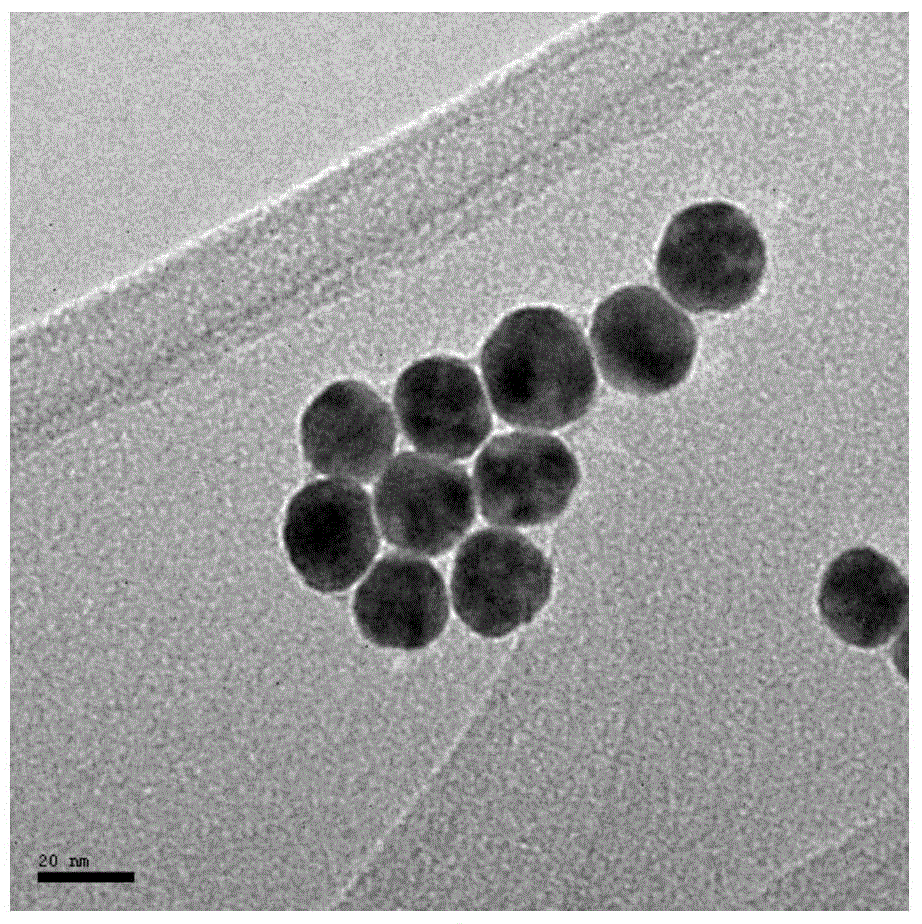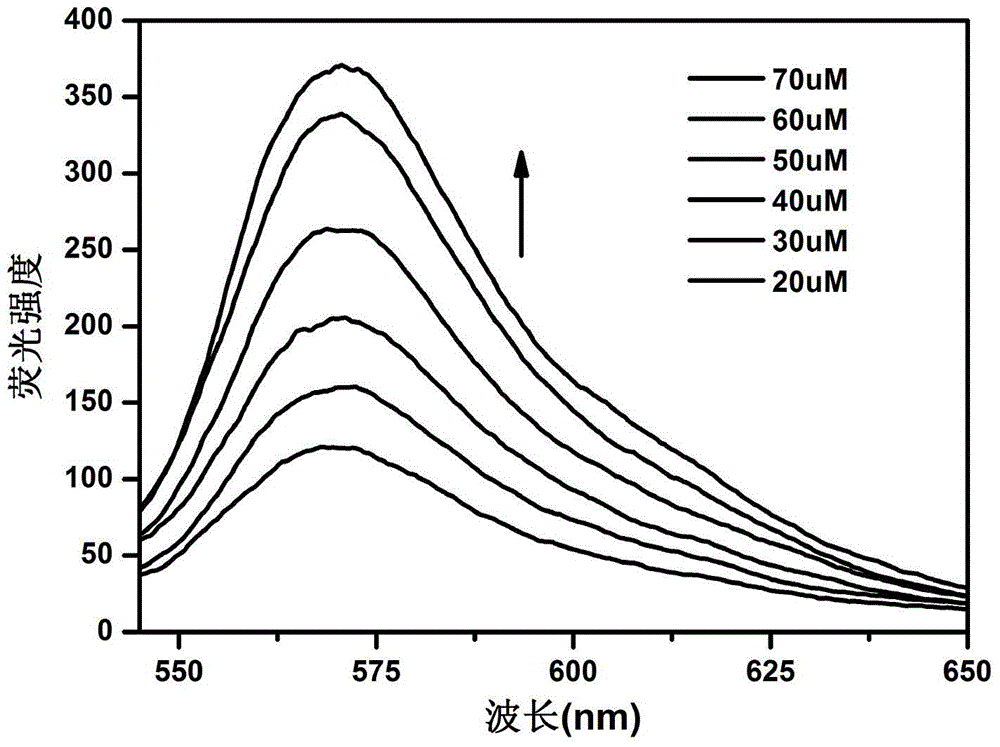Adenosine determination method based on fluorescent and colorimetric dual detection system
A dual detection and fluorescence detection technology, applied in the field of analytical chemistry, can solve the problems of low sensitivity and detection limit of adenosine detection, time-consuming and labor-consuming, a large number of samples, etc., to reduce the detection concentration and detection limit, improve sensitivity, highly specific effect
- Summary
- Abstract
- Description
- Claims
- Application Information
AI Technical Summary
Problems solved by technology
Method used
Image
Examples
Embodiment 1
[0039] The specific operation steps are as follows:
[0040] 1), synthesis of gold nanoparticles with a diameter of 13nm;
[0041] The synthesis process is as follows: 100 mL of distilled water and 2 mL of 1% chloroauric acid were added into a 250 mL three-necked flask, and heated to boiling under vigorous stirring. Then, quickly add the freshly prepared 1% sodium citrate solution into the above boiling solution, and after reacting for 15 minutes, continue stirring to cool the solution to room temperature, and store it at 4°C.
[0042] 2), modifying sulfhydryl ssDNA onto the surface of AuNPs to form a ssDNA-AuNPs system;
[0043] Change the sequence to 5'-SH-C 6 -The DNA of CAGTCTGGACCC-3' was prepared to a concentration of 10uM, and 70ul of the above DNA solution was mixed with 200ul gold nanoparticles for 16h, and then 2M NaCl was added to make the final concentration 0.1M. After washing by centrifugation for 3 times, the obtained red substance was dissolved in 200ul Tris...
Embodiment 2
[0055] The specific operation steps are as follows:
[0056] 1), synthesis of gold nanoparticles with a diameter of 5nm;
[0057] The synthesis process is as follows: add 70mL of distilled water and 10mL of 0.1% chloroauric acid into a 250mL three-necked flask, and heat to boiling under vigorous stirring. Then, quickly add the freshly prepared mixed solution of 4mL 1% sodium citrate and 5mL 1% tannic acid to the above boiling solution, after reacting for 10min, continue stirring to cool the solution to room temperature, and store it at 4°C.
[0058] 2), modifying sulfhydryl ssDNA onto the surface of AuNPs to form a ssDNA-AuNPs system;
[0059] Change the sequence to 5'-SH-C 6 -The DNA of CTGACTGGACCC-3' was formulated to a concentration of 10uM, and 70ul of the above DNA solution was mixed with 200ul of gold nanoparticles for 16h, and then 1M NaCl was added to make the final concentration 0.1M. After washing by centrifugation for 3 times, the obtained red substance was diss...
Embodiment 3
[0070] 1), synthesis of gold nanoparticles with a diameter of 30nm;
[0071] The synthesis process is as follows: 100mL of 0.01% chloroauric acid was added into a 250mL three-necked flask, and heated to boiling under vigorous stirring. Then, quickly add 1 mL of freshly prepared 1% sodium citrate solution to the above boiling solution, and after reacting for 15 minutes, continue stirring to cool the solution to room temperature, and store at 4°C.
[0072] 2), modifying sulfhydryl ssDNA onto the surface of AuNPs to form a ssDNA-AuNPs system;
[0073] Change the sequence to 5'-SH-C 6 -The DNA of GCCACTGGACCC-3' was prepared to a concentration of 10uM, and 70ul of the above DNA solution was mixed with 200ul of gold nanoparticles for 24 hours, and then 1uL of 1M NaCl was added every 5min to make the final concentration 0.1M, and washed by centrifugation with 0.1MPBS (pH7.4) for 3 After several times, the obtained red substance was dissolved in 200ul Tris-HCl (pH7.4) buffer soluti...
PUM
| Property | Measurement | Unit |
|---|---|---|
| diameter | aaaaa | aaaaa |
| diameter | aaaaa | aaaaa |
| diameter | aaaaa | aaaaa |
Abstract
Description
Claims
Application Information
 Login to View More
Login to View More - R&D
- Intellectual Property
- Life Sciences
- Materials
- Tech Scout
- Unparalleled Data Quality
- Higher Quality Content
- 60% Fewer Hallucinations
Browse by: Latest US Patents, China's latest patents, Technical Efficacy Thesaurus, Application Domain, Technology Topic, Popular Technical Reports.
© 2025 PatSnap. All rights reserved.Legal|Privacy policy|Modern Slavery Act Transparency Statement|Sitemap|About US| Contact US: help@patsnap.com



